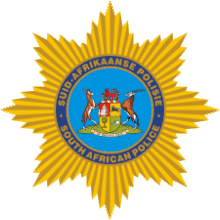Our website is made possible by displaying online advertisements to our visitors.
Please consider supporting us by disabling your ad blocker.
Security Branch (South Africa)
 Badge of the South African Police | |
| Service overview | |
|---|---|
| Formed | 1947 |
| Dissolved | April 1991 |
| Type | Security police |
| Jurisdiction | South Africa |
| Status | Defunct |
| Headquarters | Wachthuis, Pretorius Street Pretoria, South Africa |
| Parent service | South African Police |
| Part of a series on |
| Apartheid |
|---|
 |
The Security Branch of the South African Police, established in 1947 as the Special Branch,[1][2] was the security police apparatus of the apartheid state in South Africa. From the 1960s to the 1980s, it was one of the three main state entities responsible for intelligence gathering, the others being the Bureau for State Security (later the National Intelligence Service) and the Military Intelligence division of the South African Defence Force.[3] In 1987, at its peak, the Security Branch accounted for only thirteen percent of police personnel,[4] but it wielded great influence as the "elite" service of the police.[2][5][6]
In addition to collecting and evaluating intelligence, the Branch also had operational units, which acted in neighbouring countries as well as inside South Africa, and it housed at least one paramilitary death squad, under the notorious Section C1 headquartered at Vlakplaas. It is also well known for recruiting askaris (informants, double agents, and defectors), and for the systematic[6] use of torture and numerous deaths in its detention facilities. Branch officers carried out the murders of Ruth First, Ahmed Timol, the Pebco Three, and The Cradock Four, among many other anti-apartheid activists; Steve Biko died in Security Branch custody after being severely beaten by officers.[7][8][9] Famous Branch investigations include those leading to the 1956 Treason Trial, the 1963 Rivonia Trial, the 1964 Little Rivonia Trial, and the 1990 Operation Vula trial. It also carried out "Stratcom" disinformation and "dirty tricks" operations which some have likened to a "propaganda war" against the African National Congress.[6]
The Truth and Reconciliation Commission (TRC) found that the Security Branch engaged in "massive and systematic destruction of records" in 1992 and 1993, following an instruction from head office in 1992.[10] As a result, the details of many of the Branch's operations remain unknown or uncorroborated. Several former members, though a small proportion of the overall staff complement, submitted amnesty applications to the TRC and testified at length about the Branch's involvement in extrajudicial killings and other human rights violations.[11]
- ^ Shear, Keith (2012). "Tested loyalties: police and politics in South Africa,1939—63". The Journal of African History. 53 (2): 173–193. doi:10.1017/S0021853712000370. ISSN 0021-8537. JSTOR 23353654. S2CID 153477610.
- ^ a b Dlamini, Jacob (2020). The Terrorist Album: Apartheid's Insurgents, Collaborators, and the Security Police. Harvard University Press. ISBN 978-0-674-91655-5.
- ^ Buys, Jane Elize (2007). The transformation of the South African Police from a paramilitary force to a service delivery agency 1980-1998: a historical assessment (PhD thesis). University of the Free State.
- ^ O'Brien, Kevin (2001-09-01). "Counter-Intelligence for counter-revolutionary warfare: The South African police security branch 1979–1990". Intelligence and National Security. 16 (3): 27–59. doi:10.1080/02684520412331306200. ISSN 0268-4527. S2CID 153561623.
- ^ Steinberg, J. (2014-04-01). "Policing, state power, and the transition from apartheid to democracy: A new perspective". African Affairs. 113 (451): 173–191. doi:10.1093/afraf/adu004. ISSN 0001-9909.
- ^ a b c Report of the Truth and Reconciliation Commission of South Africa (PDF). Vol. 2. Cape Town: The Commission. 1998.
- ^ Elnaiem, Mohammed (2020-09-17). "The Death of Steve Biko, Revisited". JSTOR Daily. Retrieved 2021-11-26.
- ^ Burns, John F. (1977-12-03). "South African Inquest Absolves Security Police in Biko's Death". The New York Times. ISSN 0362-4331. Retrieved 2021-11-26.
- ^ Truth and Reconciliation Commission (1999-02-16). "Press statement: Amnesty decision on death of Steve Biko". Department of Justice. Retrieved 2021-11-30.
- ^ Report of the Truth and Reconciliation Commission of South Africa (PDF). Vol. 1. Cape Town: The Commission. 1998.
- ^ "Decisions of the Amnesty Committee" (PDF). Department of Justice. 1999. Retrieved 2021-11-25.
Previous Page Next Page


